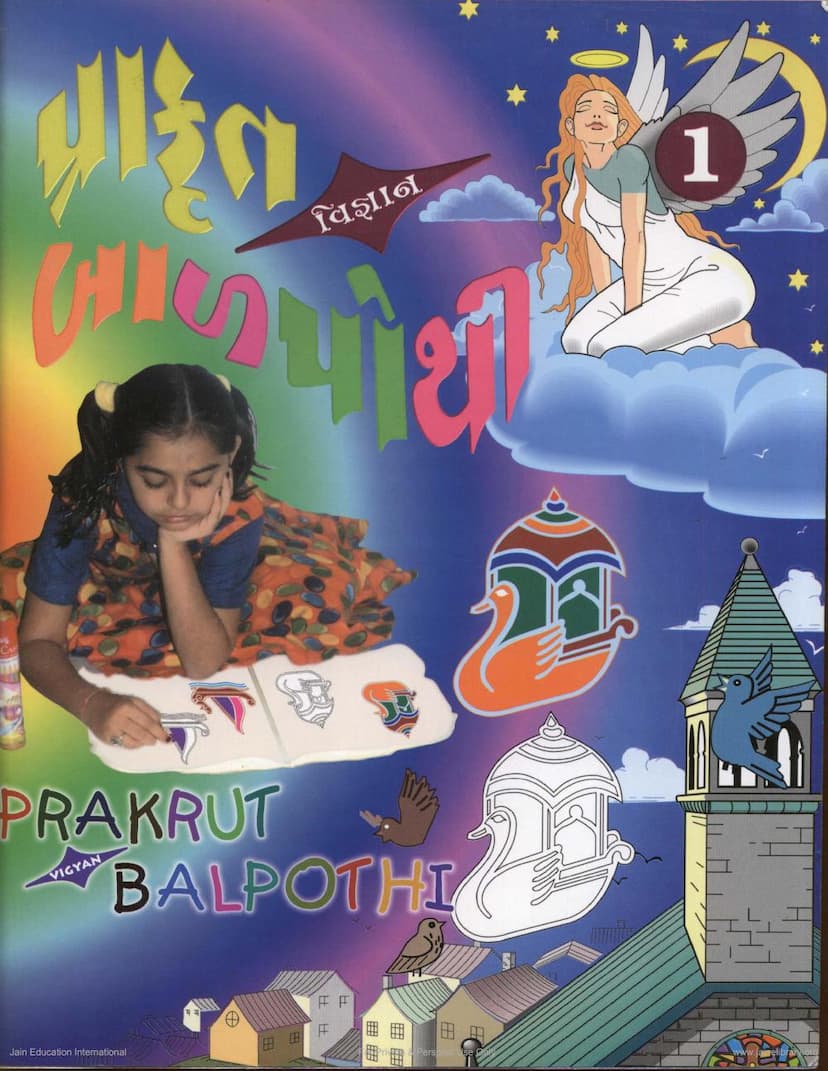Prakrit Vigyana Balpothi Part 1
Added to library: September 2, 2025

Summary
This document is a detailed overview and introduction to "Prakrit Vigyana Balpothi Part 1," a Jain educational text focused on the Prakrit language. Here's a comprehensive summary of its content:
Book Title: Prakrit Vigyana Balpothi Part 1 Author: Somchandravijay (as editor) Publisher: Rander Road Jain Sangh, Surat Catalog Link: https://jainqq.org/explore/004629/1
Overall Purpose and Theme:
The book is a pedagogical tool designed to introduce children to the Prakrit language, which is considered the "mother tongue" of the Jain tradition and is essential for understanding Jain scriptures. It aims to revive and promote the Prakrit language, which has become less common over time.
Key Figures and Dedication:
- Acharya Shri Vijay Kastursurishwarji: The book is dedicated to him, celebrating his birth centenary. He was a scholar of Prakrit who initiated the creation of this "Balpothi" (children's book) with the intention of making Prakrit accessible to young learners.
- Acharya Shri Vijay Nemisurishwarji Maharaj Saheb: Revered as "Shasan Samrat" (Emperor of the Jain Faith).
- Acharya Shri Vijay Vigyansurishwarji Maharaj Saheb: Revered as "Vatsalyavaridhi" (Ocean of Compassion) and "Samayagna" (Knower of Time).
- Acharya Shri Vijay Chandrodayasurishwarji M.S. and Acharya Shri Vijay Ashokchandrasurishwarji M.S.: Provided inspiration and guidance.
- Muni Shri Shrichandravijayji M.S. and Muni Shri Jineshandravijayji M.S.: Served as co-editors.
- Late Pt. Narmadashankar Shastri: The original coordinator of the work.
Content and Structure (as described in the editorial and foreword):
The "Prakrit Vigyana Balpothi" is designed in four parts:
- Part 1: Features Jain symbols with child-friendly pictures.
- Part 2: Includes pictures, Prakrit characters (matrukaakshara), and simple sentences.
- Parts 3 & 4: Cover Prakrit vocabulary, verb roots (dhatavo), their forms, and usage.
The book is also noted to include Sanskrit verses and exercises in the appendices. The content is presented with translations in Sanskrit, Gujarati, and English to cater to modern learners.
Genesis and Publication History:
- The original concept for the "Prakrit Vigyana Balpothi" was conceived by Acharya Shri Vijay Kastursurishwarji about 36 years prior to the current publication, in collaboration with Pandit Narmadashankar Shastri of Bhavnagar, inspired by Raichandbhai Maganlal.
- The book was not published during Acharya Kastursurishwarji's lifetime.
- It was finally published in four volumes around January 2000, coinciding with the celebration of Acharya Kastursurishwarji's 100th birth anniversary.
- The current publication is the second edition, addressing the immediate need for more copies due to high demand, especially after an examination was introduced for the material by the Mumbai Jain Religious Education Sangh.
- The publication was made possible through the blessings of Acharya Kastursurishwarji, guidance from other Acharyas, hard work of the editors and supporting monks, contributions from various Jain organizations (sanghs), and the efforts of Nehaj Enterprise for printing and binding.
Key Features and Educational Approach:
- Visual Learning: Emphasizes the use of pictures and illustrations, especially in the initial parts, to engage young learners.
- Multilingual Approach: Provides parallel texts in Prakrit, Sanskrit, Gujarati, and English to aid comprehension and learning.
- Progressive Learning: The book is structured to gradually introduce Prakrit, starting with symbols and basic words, progressing to grammar and usage.
- Cultural Revival: Aims to reconnect the younger generation with the heritage language of Jainism.
Testimonials and Appreciations:
- The editorial and foreword sections express gratitude to all individuals and organizations that contributed to the book's publication.
- There's a mention of a specific family (Shri Naminath Shah family of Ahmedabad) sponsoring the publication, honoring their mother Dhanlaxmiben Navinchandra Shah.
Visual Content (Pages 13 onwards):
The latter pages of the document showcase sample pages from the "Balpothi," demonstrating its structure and content. These pages include:
- Basic Jain terms: "Namukaar" (Namascar) with its equivalents in Prakrit, Sanskrit, Gujarati, and English.
- Jain places and objects: "Jinaalaya" (Temple), "Omkaar," "Hrimkaara," "Asthamangal" (Eight Auspicious Symbols) like Swastik, "Shrivatsa," "Kalas" (Pitcher), "Sinhasaana" (Throne), "Nandaavrata," "Vaddhamaan Samputa," "Meenajugala" (Pair of Fish), "Darpan" (Mirror).
- Jain iconography and symbols: Images of "Gaya" (Elephant), "Vasaaha" (Bull), "Sinha" (Lion), "Lachchhi" (Goddess Lakshmi), "Pushpamala" (Garland), "Chand" (Moon), "Sur" (Sun), "Dhay" (Flag), "Kumbh" (Pitcher), "Paumasara" (Lotus Lake), "Saayar" (Sea), "Vimaan" (Plane), "Rayanaraasi" (Pile of Gems), "Niddhoom Agni" (Smokeless Fire), "Ashoka Tree," "Chhatta" (Umbrella), "Surapupfavrutthi" (Flowers falling by Gods), "Divvaazunnie" (Divine Music), "Chamara" (Chamar), "Sinhaasana" (Throne), "Dunduhi" (Drum), "Bhaamandal" (Aureole).
- Symbols of Tirthankaras: The document lists the first 24 Tirthankaras and their associated symbols (Laanchhanaani). This section highlights the visual learning approach by pairing the Tirthankara's name with their emblem, with the emblem's name provided in Prakrit, Sanskrit, Gujarati, and English. Examples include:
- Adinath: Bullock
- Ajitnath: Elephant
- Sambhavnath: Horse
- Abhinandanswami: Monkey
- Sumatinath: Kauch Bird
- Padmaprabhswami: Lotus
- Suparshwanath: Swastik
- Chandraprabhswami: Moon
- Suvidhinath: Crocodile
- Sheetalnath: Shrivatsa
- Shreyansnath: Rhinoceros
- Vasupujyaswami: Buffalo
- Vimalnath: Pig
- Ananthnath: Hawk
- Dharmanath: Vajra (Indra's weapon)
- Shantinath: Deer
- Kunthunath: Goat
- Aranath: Swastik
- Mallinath: Pitcher
- Munisuvratswami: Tortoise
- Naminath: Green Lotus
- Neminath: Conch Shell
- Parshwanath: Snake
- Mahavirswami: Lion
- Jain practices and items: "Saahunia" (Sadhu/Sadhvi), "Rayaharana" (Broom for monks), "Patta" (Leaf/Plate), "Tarappania," "Maalaa" (Garland), "Deepak" (Lamp), "Aaratiya" (Aarti), "Jainapaia" (Jain Symbol), "Dhay" (Flag).
- A simple sentence: "Bhaarahomajjha Deso Aatthi" (India is my country) with its Sanskrit and Gujarati translations.
- Activities for children: Pages with instructions for coloring and numbering.
In essence, "Prakrit Vigyana Balpothi Part 1" is a significant educational resource for introducing the foundational elements of the Prakrit language and Jain symbolism to children, meticulously compiled and presented with the blessings and efforts of many esteemed Jain scholars and organizations.